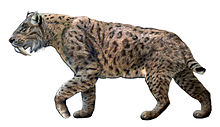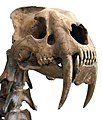Saber-toothed predator

A saber-tooth (alternatively spelled sabre-tooth) is any member of various extinct groups of
One of the best-known genera is the
Of the feliform lineages, the family Nimravidae is the oldest, entering the landscape around 42 mya and becoming extinct by 7.2 mya. Barbourofelidae entered around 16.9 mya and were extinct by 9 mya. These two would have shared some habitats.
Morphology
This section needs additional citations for verification. (April 2015) |
The different groups of saber-toothed predators evolved their saber-toothed characteristics entirely independently. They are most known for having maxillary canines which extended down from the mouth when the mouth was closed. Saber-toothed cats were generally more robust than today's cats and were quite bear-like in build. They are believed to have been excellent hunters, taking animals such as sloths, mammoths, and other large prey. Evidence from the numbers found at the La Brea Tar Pits suggests that Smilodon, like modern lions, was a social carnivore.[7]
The first saber-tooths to appear were non-mammalian
The second appearance is in Deltatheroida, a lineage of Cretaceous metatherians. At least one genus, Lotheridium, possessed long canines, and given both the predatory habits of the clade as well as the generally incomplete material, this may have been a more widespread adaptation.[9]
The third appearance of long canines is Thylacosmilus, which is the most distinctive of the saber-tooth mammals and is also easy to tell apart. It differs from machairodonts in possessing a very prominent flange and a tooth that is triangular in cross section. The root of the canines is more prominent than in machairodonts and a true sagittal crest is absent.
The fourth instance of saber-teeth is from the clade Oxyaenidae. The small and slender Machaeroides bore canines that were thinner than in the average machairodont. Its muzzle was longer and narrower.
The fifth saber-tooth appearance is the ancient feliform (carnivoran) family Nimravidae. Both groups have short skulls with tall sagittal crests, and their general skull shape is very similar. Some have distinctive flanges, and some have none at all, so this confuses the matter further. Machairodonts were almost always bigger, though, and their canines were longer and more stout for the most part, but exceptions do appear.
The sixth appearance is the barbourofelids. These feliform carnivorans are very closely related to actual cats. The best-known barbourofelid is the eponymous Barbourofelis, which differs from most machairodonts by having a much heavier and more stout mandible, smaller orbits, massive and almost knobby flanges, and canines that are farther back. The average machairodont had well-developed incisors, but barbourofelids' were more extreme.
The seventh and last saber-toothed group to evolve were the machairodonts themselves.
-
1st saber-tooth instance: angusticeps skull
-
5th saber-tooth instance: Nimravidae (Feliformia, Carnivora) – Hoplophoneus primaevus skull and upper cervical vertebrae
-
6th saber-tooth instance: Barbourofelidae (Feliformia, Carnivora) – Barbourofelis skeleton
-
7th saber-tooth instance: Machairodontinae (Felidae, Feliformia, Carnivora) – Smilodon skull and upper cervical vertebrae
Diet

The evolution of enlarged canines in Tertiary carnivores was a result of large mammals being the source of prey for saber-toothed predators. The development of the saber-toothed condition appears to represent a shift in function and killing behavior, rather than one in predator-prey relations. Many hypotheses exist concerning saber-tooth killing methods, some of which include attacking soft tissue such as the belly and throat, where biting deep was essential to generate killing blows. The elongated teeth also aided with strikes reaching major blood vessels in these large mammals. However, the precise functional advantage of the saber-tooth's bite, particularly in relation to prey size, is a mystery. A new point-to-point bite model is introduced in the article by Andersson et al., showing that for saber-tooth cats, the depth of the killing bite decreases dramatically with increasing prey size.[10] The extended gape of saber-toothed cats results in a considerable increase in bite depth when biting into prey with a radius of less than 10 cm. For the saber-tooth, this size-reversed functional advantage suggests predation on species within a similar size range to those attacked by present-day carnivorans, rather than "megaherbivores" as previously believed.
A disputing view of the cat's hunting technique and ability is presented by
Biology
The similarity in all these unrelated families involves the convergent evolution of the saber-like canines as a hunting adaptation. Meehan et al.
More recently, it has been suggested that Thylacosmilus differed radically from its placental counterparts in possessing differently shaped canines and lacking incisors. This suggests that it was not ecologically analogous to other saber-teeth and possibly an entrail specialist.[14] Another study has found that other saber toothed species similarly had diverse lifestyles and that superficial anatomical similarities obscure them.[15]
Phylogeny of feliform saber-tooths
Saber-tooth taxonomy
All saber-toothed mammals lived between 33.7 million and 9,000 years ago, but the evolutionary lines that led to the various saber-tooth genera started to diverge much earlier. It is thus a
The lineage that led to
- Class: Mammalia
- Clade: Metatheria (diverged ?, in the Cretaceous)
- Order: †Deltatheroida (an extinct group of metatherian carnivores)
- Family: †Deltatheridiidae
- Order: †Sparassodonta (an extinct group of metatherian carnivores)
- Family: †Thylacosmilidae
- Order: †Deltatheroida (an extinct group of metatherian carnivores)
- Subclass: Placentalia
- Order: †Hyaenodonta
- †Boualitomus
- Family: †Sinopidae
- Genus: †Sinopa
- Superfamily: †Hyaenodontoidea
- Family: †Hyaenodontidae
- Subfamily: †Hyaenodontinae
- Tribe: †Hyaenodontini
- Genus: †Hyaenodon
- Tribe: †Hyaenodontini
- Subfamily: †Hyaenodontinae
- Family: †Proviverridae
- Family: †Hyaenodontidae
- Superfamily: †Hyainailouroidea
- Family: †Hyainailouridae (paraphyletic family)
- Subfamily: †Hyainailourinae (paraphyletic subfamily)
- Tribe: †Leakitheriini
- Genus: †Leakitherium
- Tribe: †Metapterodontini
- Genus: †Metapterodon
- Tribe: †Leakitheriini
- Subfamily: †Hyainailourinae (paraphyletic subfamily)
- Family: †Hyainailouridae (paraphyletic family)
- Order: †Oxyaenodonta
- Family: †Oxyaenidae
- Subfamily: †Machaeroidinae
- Genus: †Apataelurus
- Genus: †Machaeroides
- Subfamily: †Machaeroidinae
- Family: †Oxyaenidae
- Order Carnivora
- Family †Nimravidae (diverged from the feliforms 48–55 Ma BP, in the late Eocene)
- Subfamily †Nimravinae (Dinictis)
- Subfamily †Hoplophoninae
- Suborder Feliformia ('cat-like' carnivores)
- Family †Barbourofelidae (sister taxa to Felidae)
- Family Felidae (true cats)
- Subfamily †Machairodontinae (diverged ?, in the ?)
- Tribe †Homotherini
- Tribe †Metailurini
- Tribe †Smilodontini
- †Megantereon
- †Paramachairodus
- †Smilodon
- Subfamily †Machairodontinae (diverged ?, in the ?)
- Family †Nimravidae (diverged from the feliforms 48–55 Ma BP, in the late Eocene)
- Order: †Hyaenodonta
- Clade: Metatheria (diverged ?, in the Cretaceous)
References
- ^ "PaleoBiology Database: Smilodon, basic info". Paleodb.org. Retrieved 2012-09-06.
- ^ "PaleoBiology Database: Nimravidae, basic info". Paleodb.org. Retrieved 2012-09-06.
- ^ "PaleoBiology Database: Barbourofelidae, basic info". Paleodb.org. Retrieved 2012-09-06.
- PMID 26893959.
- ^ Antón, Mauricio (2013). Sabertooth (Life of the Past). Indiana University Press.
- S2CID 86749260.
- PMID 18957359.
- S2CID 35831378.
- PMID 25893149.
- PMID 22039403.
- ^ ISBN 0226070891
- S2CID 21117744.
- PMID 21672827.
- PMID 32617190.
- PMID 32993469.
- PMID 23925509.
- ^ Piras P, Maiorino L, Teresi L, Meloro C, Lucci F, Kotsakis T, Raia P (2013) Data from: Bite of the cats: relationships between functional integration and mechanical performance as revealed by mandible geometry. Dryad Digital Repository. https://dx.doi.org/10.5061/dryad.kp8t3
Further reading
- Mol, D., W. v. Logchem, K. v. Hooijdonk, R. Bakker. The Saber-Toothed Cat. DrukWare, Norg 2008. ISBN 978-90-78707-04-2.
- Sardella, R. (10 March 2012). "Web of Knowledge (v5.6)". Soc Paleontologica Italiana.[dead link]
- Anton, Mauricio (2013). Sabertooth. Bloomington: Indiana University Press. ISBN 978-0253010490.
External links
- Saber-toothed Cats at the Illinois State Museum
- Saber-toothed Cats at the UC Berkeley Museum of Paleontology
- Prehistoric cats and prehistoric cat-like creatures






